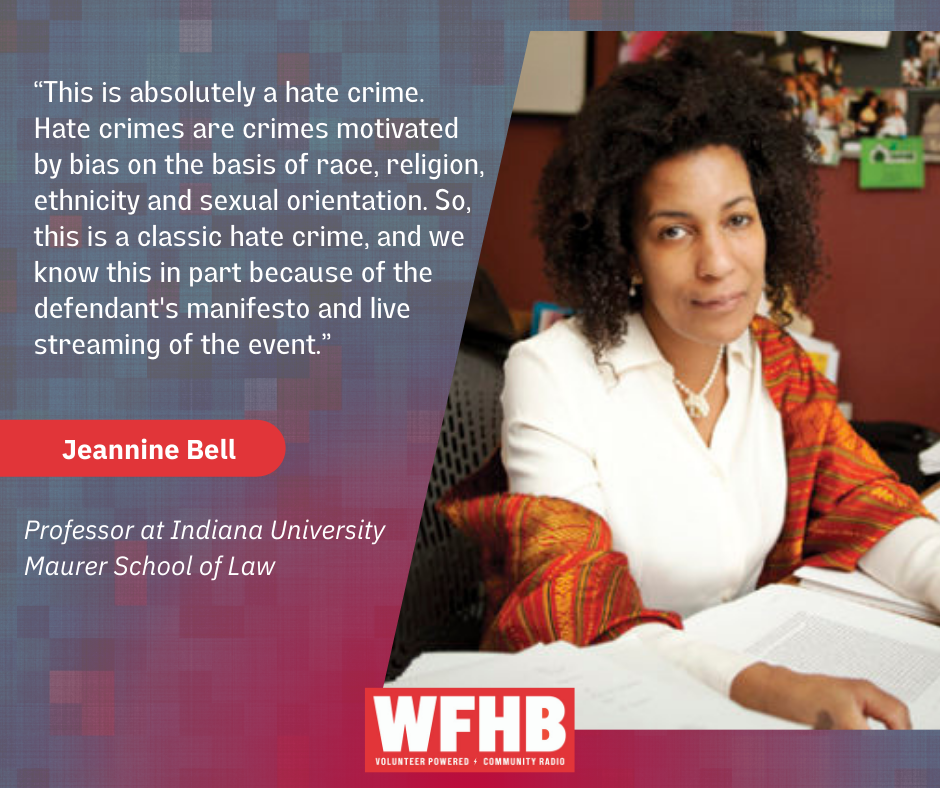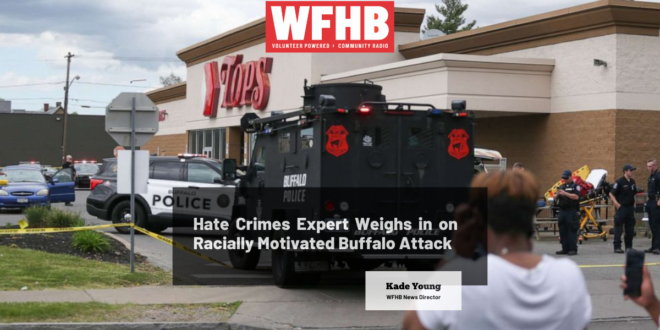Podcast: Play in new window | Download (Duration: 8:49 — 12.2MB)
Subscribe: RSS
On Saturday, an armed 18-year-old white man killed 10 people and injured three others at a Buffalo, New York grocery store. Almost all of the victims were Black.
A manifesto written by the shooter who traveled more than three hours to commit these egregious acts, reveals the attack was racially motivated. Police are now investigating the shooting as a hate crime.
Professor Jeannine Bell, a nationally recognized scholar on the subject of policing and hate crimes at the IU Mauer School of Law, says she’s not surprised by the tragic incident.
“It’s a tragedy, but I’m not surprised by it – in part because I’m a hate crimes scholar and I’ve watched incidents happen around the country in recent years, and this is sadly more of what’s to come,” said Bell.
In her expert legal opinion, Bell says that the shooting provides a textbook example of what constitutes a hate crime.
“This is absolutely a hate crime,” said Bell. “Hate crimes are crimes motivated by bias on the basis of race, religion, ethnicity and sexual orientation. So, this is a classic hate crime, and we know this in part because of the defendant’s manifesto and live streaming of the event.”
The shooter had visited white supremacist websites prior to the incident and was an adherant to the so-called Great Replacement Theory.
According to the National Immigration Forum, the Great Replacement Theory states that, “welcoming immigration policies — particularly those impacting nonwhite immigrants — are part of a plot designed to undermine or “replace” the political power and culture of white people living in Western countries.”
Bell touched on the rise of white supremacy and how these hateful viewpoints have the ability to thrive in today’s media landscape.
“First of all, it’s important to note that the great replacement theory is something that’s not new. It’s a long, old white supremacist approach and view. So it’s something that’s not new but the current environment with respect to social media, the space for these views, has absolutely allowed the views to proliferate and adherents of these extreme views to find each other,” she said.

Bell speculates that rulings like the not guilty verdict in the Kyle Rittenhouse trial and other dog-whistling to white supremacists by elected officials and media personalities have emboldened white supremacists to commit the atrocious act seen in recent days.
Bell explained that this sort of apathy toward white supremacist violence sets a harmful precedent that normalizes hate.
“The result in the Rittenhouse trial and the not guilty verdict in that context and the dog whistle by politicians and by individuals, as part of the media absolutely suggest to extremists, that their beliefs are acceptable and that they should go out and continue to express views and do things in keeping with views that are really counter to American ideals of inclusivity,” said Bell.
The United States has a long history of white supremacist violence. Bell described the similarities and differences in the form of white supremacy seen today versus white supremacist violence in the days of Emmett Till or other racially motivated killings seen in the past.
“One big difference is that in the past, mob violence was a huge force. Lynchings, for instance, often involved entire communities watching present as black bodies lay swinging from ropes,” she said. “Now, white supremacists whose organizations may be sued and bankrupted by lawsuits have adopted a lone wolf approach to violence such that they say this is our ideology, but you are to engage in this behavior on your own.”
Bell says she’s not sure what can be done when it comes to policy or even on a societal level, to prevent such horrifying acts from happening in the future. However, she says addressing the issue is the first step in any tangible change moving forward.
“We don’t know whether we can prevent them, but we might spend more time actually addressing them. The vast majority of law enforcement agencies in the United States do not even investigate hate crime. The most recent FBI report, more than 80 percent of law enforcement agencies suggested that not a single hate crime occurred in their jurisdiction. That suggests that they are doing nothing, and that’s the way that most community police departments approach hate crime. We can’t even talk about ending this sort of violence, if we’re not even doing very much at all to address it,” said Bell.
The Buffalo community continues to mourn in the aftermath of such hate and tragedy that has befallen that community. Bell offered some words of solace for the victims and the community of Buffalo in the wake of the devastation.
“The community of Buffalo needs to come together, not just the African American community, but the community as a whole needs to reach out to African Americans in the community and say this is not something that we do not support,” said Bell. “Moreover, we will redouble our efforts to address individuals in the community who express these sorts of views before they get to this particular extent. That is the way that the community in Buffalo can best respond and recover to the extent they can from an incident like this.”
 WFHB Bloomington Community Radio
WFHB Bloomington Community Radio


